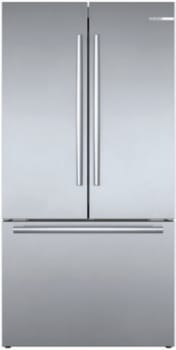GE Profile 21.9 cu. ft. Side by Side Refrigerator in Fingerprint Resistant Stainless Steel, Counter Depth
Resists fingerprints and smudges for a clean sleek appearance. LED lighting makes items easy to spot and retrieve. Quickly restore temperatures with an extra boost of cold air.
Built on the belief that modern life needs modern solutions. GE Profile Appliances are designed to make daily life simpler by incorporating Smart Home technology and cutting-edge features in every appliance. GE Profile’s sleek design and quality engineering will give your kitchen the most up-to-date look and the best innovative performance you’ve been looking for.
- Fingerprint Resistant Stainless – Easily wipe away smudges and fingerprints for a look that’s always sparkling clean
- Counter Depth Design – Enjoy a built-in look in the kitchen thanks to a counter depth refrigerator that fits nearly flush with cabinets and counters
- Showcase LED Lighting – Easily find even the smallest food items thanks to 7 flush-mounted LED lights, which shed more crisp, even light throughout the interior without wasting space
- Turbo Cool setting – Quickly bring down the interior refrigerator temperature thanks to an innovative Turbo Cool setting, which circulates an extra boost of cold air throughout the interior when selected
- Quick Ice setting – this refrigerator’s icemaker features a cutting-edge Quick Ice setting which creates ice up to 50% faster than normal settings
- QuickSpace Shelf – the perfect place for everything in your refrigerator, even tall items thanks to a space saving shelf system which easily slides back to create more room
- Interior Storage Drawers – 3-refrigerator pull out drawers with clear fronts provide the perfect, sealed environment to keep your produce organized
- Adjustable Glass Shelves – Contain spills and make cleanup quick and easy, thanks to spill proof glass shelving with raised edges
- Easy Access Icemaker – Automatically create cubed or crushed ice thanks to a factory-installed, low Profile icemaker
- External Dispenser – Get advanced filtered water and ice from a specially engineered, seamless dispenser located on the outside of the door
- Electronic Display – always get the refrigerator temperature just right with a sleek electronic display that allows for precise settings
- Advanced Water Filtration – Reduces impurities, lead and trace pharmaceuticals from water and ice (removes 98% of ibuprofen, atenolol, fluoxetine, progesterone and trimethoprim, Impurities are not necessarily in all users’ water)
- Glass Freezer Shelves – easily store even the smallest or thinnest items in the freezer section thanks for durable glass shelving
- Freezer Baskets – 2-organizational freezer baskets provide plenty of easy-access storage for frozen foods
- Adaptive Defrost – with FrostGuard technology, your freezer will only defrost when needed, as opposed to a time cycle, leading to less freezer burn and more energy savings
- Enhanced Shabbos Mode – the Shabbos Keeper connects to your refrigerator to automatically enable Shabbos compatible modes each week and before every holiday (Shabbos Keeper sold separately, visit www.zmantechnologies.com for details)
- Limited 1-year entire appliance warranty
Additional information
| Depth (Excluding Handles) | 28.5 in |
|---|---|
| Depth (Including Handles) | 30.75 in |
| Depth (Less Door) | 24.125 |
| Depth With Door Open 90 Degrees (In) | 46.25 |
| Height to Top of Door Hinge (in.) | 69.875 in |
| Height to Top of Refrigerator (in.) | 69.25 in |
| Product Depth (in.) | 30.75 |
| Product Height (in.) | 69.25 |
| Product Width (in.) | 35.75 |
| Refrigerator Width (In.) | 35.75 |
| Certifications and Listings | UL Listed |
| Manufacturer Warranty | Limited 1-year entire appliance warranty |







by Dan
Great refrigerator, but could use more room inside.
by Madhu
Have been using GE products for 25+ years – would like more freezer space but i have those options in other models – this is perfect size for 2 people.
by Madge
I love this counter depth refrigerator. I prefer this side by side over my previous freezer on the bottom. I like the pull open wire like shelves in freezer door. Ample room in this product for two person household. This fingerprint resistant stainless steel product cleans easily using soft cloth, water and mild soap. Runs quietly. Drawers in fridge and freezer are good sizes.
by Diedra
Perfect fit in my kitchen.. last fridge was a bit bigger.. will force me to buy less food!!
by Sean
We are moving from a failed Samsung so what a welcome change. Quiet, great ice maker, keep food ice cold!!
by Silva
Looks very nice, quite, and makes ice fast. And is well lit on the inside.
by Suebe
Love the counter depth and finish. Customer service is excellent. All my appliances are GE. Replaced Samsung for better quality and Service.
by James
Love the finish of this refrigerator. Very quiet!